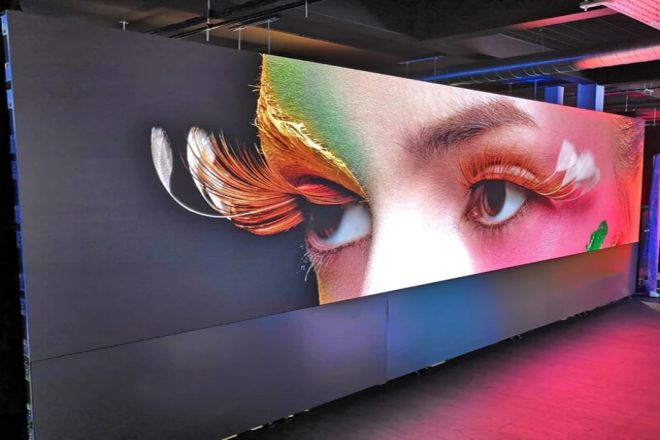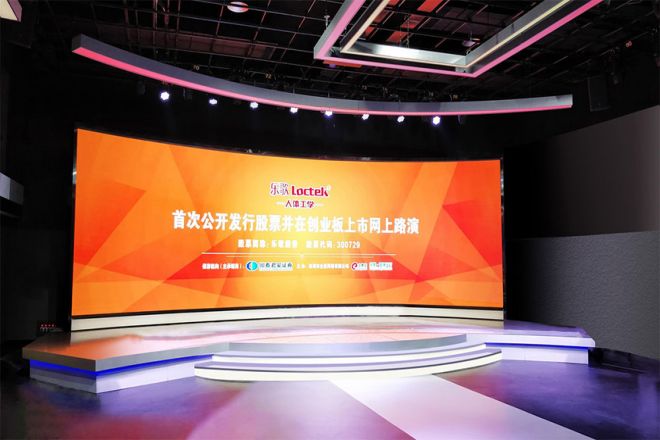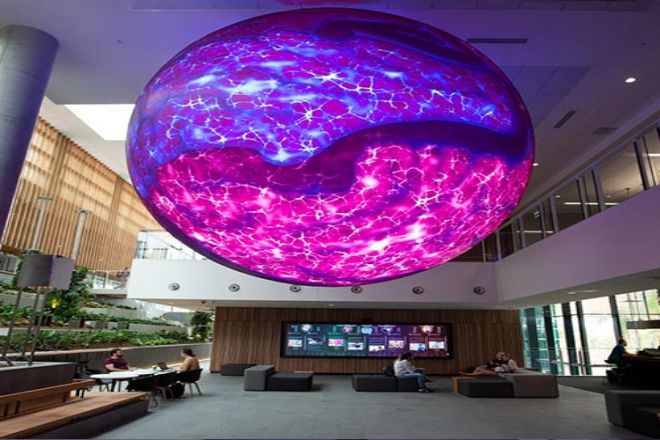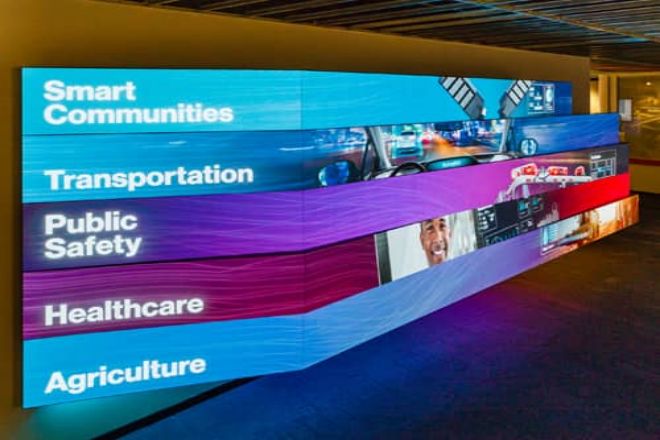소개

With the rapid development of science and technology and the advent of the digital age, 발광 다이오드 표시 스크린, as an efficient, energy-saving, and environmentally friendly display device, have been widely used in advertising media, stage performances, sports events, conferences and exhibitions, and other fields.
However, with the intensification of market competition, how LED display screen companies can reasonably control costs and increase profits while ensuring product quality has become the focus of industry attention.
1. Cost analysis of LED display screens

1). Material cost
- LED 칩:
The LED chip is the core component of LED display screens, and its cost is affected by factors such as chip type, size, and brightness. With the advancement of technology, the cost of LED chips has been reduced by improving light efficiency, but it is still an important part of the overall cost.
- PCB substrate:
The cost of PCB substrate is mainly composed of material cost, processing cost, and labor cost. Among them, material cost includes substrate material, circuit board material, and copper foil, and processing cost includes drilling, copper plating, graphic etching, and other process costs.
- Packaging materials:
Packaging materials such as packaging substrates, wires, chip bases, etc., are necessary components in the packaging process of LED display screens, and their cost usually accounts for one-third to one-half of the total packaging cost.
- Driver IC and power supply:
Driver IC and power supply are key components that ensure the normal operation of LED display screens. Their costs are affected by factors such as circuit design, power size, and brand.
- Auxiliary materials such as frames and heat sinks:
Although these auxiliary materials account for a small proportion, they are also part of the overall cost of LED display screens. In particular, the choice of frame materials has a certain impact on the cost.
2). Production cost
- Depreciation of manufacturing equipment:
The equipment required to produce LED display screens, such as SMT placement machines, reflow soldering machines, etc., will depreciate as the use time increases, which is also part of the production cost.
- Labor cost:
Labor costs include wages, benefits, and insurance premiums for workers directly involved in production, as well as wages for managers and equipment maintenance engineers who are indirectly involved.
- 에너지 소비:
The production process of LED display screens consumes resources such as electricity, which is also part of the production cost.
- Quality control and testing costs:
In order to ensure the quality of LED display screens, a series of quality controls and tests are required, which will incur corresponding costs.
3). R&D and design costs
- R&D team salary:
The R&D team is the key force in the design and innovation of LED display screens, and its salary is an important part of the R&D cost.
- Patent fees:
Patent fees that may be involved in the R&D process, including application fees, maintenance fees, etc.
- Design software and tool costs:
design software and simulation tools used for R&D.
4) Marketing and sales costs
- 시장 조사 비용:
In order to understand market demand and competitive situation, enterprises need to conduct market research, which will incur corresponding costs.
- Advertising and promotion costs:
In order to increase product awareness and market share through advertising and promotion activities, these activities require a certain amount of investment.
- Sales staff salary and commission:
Sales staff salary and performance commission are important components of marketing and sales costs.
- Channel construction and maintenance costs:
Building and maintaining sales channels requires human, Material, and financial resources.
5). Logistics and transportation costs
- Transportation costs:
The costs incurred in transporting LED displays from the place of production to the place of sale or the hands of customers.
- Warehousing costs:
Costs incurred during storage, including warehouse rent, equipment depreciation, management costs, etc.
- Cargo insurance costs:
In order to ensure the safety of goods during transportation, it may be necessary to purchase cargo insurance.
2. LED display cost calculation method
1). Direct cost calculation
- Material cost summary
First, it is necessary to list all the materials used to produce LED display screens, including LED chips, PCB substrates, packaging materials, driver ICs, and auxiliary materials such as power supplies, frames, heat sinks, etc.
According to the actual purchase price, the cost of each Material is summarized to obtain the total material cost.
- Production cost allocation
Production costs mainly include depreciation of manufacturing equipment, labor costs, energy consumption, and quality control and testing costs.
Equipment depreciation can be allocated according to the purchase price and service life of the equipment.
Labor costs are calculated based on the number of workers involved in production, working hours, and wage levels.
Energy consumption is usually calculated based on the actual electricity consumption and electricity prices during the production process.
Quality control and testing costs are estimated based on the number of tests, equipment, and personnel costs.
2). Indirect cost calculation
- R&D and design cost allocation
R&D and design costs include R&D team salaries, patent fees, design software, and tool fees, etc.
These costs can be allocated based on the project’s R&D cycle, number of participants, and R&D progress.
- Marketing and sales cost allocation
Marketing and sales costs include market research costs, advertising and promotion costs, sales staff salaries and commissions, channel construction and maintenance costs, etc.
These costs can be allocated based on sales, market share, or sales cycle.
Logistics and transportation cost allocation
Logistics and transportation costs include transportation costs, warehousing costs, and cargo insurance costs.
These costs can be allocated based on transportation distance, transportation volume, storage area, and cargo value.
3). Total cost calculation
Add up the direct costs and indirect costs to get the total cost of the LED display.
The specific calculation formula is Total cost = Material cost + Production cost + R&D and design cost + Marketing and sales cost + Logistics and transportation cost.
During the calculation process, it is necessary to pay attention to the accuracy and rationality of each cost and make appropriate adjustments according to the actual situation. In addition, enterprises can also formulate corresponding cost control strategies based on the results of cost analysis to improve production efficiency and reduce costs.
3. LED display pricing strategy

1). Cost-plus pricing method
- Determine the cost-plus rate.
The cost-plus rate is the proportion that the enterprise adds to the product cost in order to obtain the target profit. This ratio is usually determined by factors such as the company’s profit target, market conditions, and industry competition.
For example, if the company sets a cost markup of 20%, the selling price of the product is 1.2 times the cost.
- Calculate product selling price
Selling price = cost × (1 + cost markup)
Assuming that the total cost of the LED display is 10,000 yuan and the cost markup is 20%, the selling price = 10,000 × (1 + 20%) = 12,000 yuan.
2). Competition-oriented pricing method
- Analyze competitor prices
Enterprises need to pay close attention to the prices of similar products on the market, especially the pricing strategies of competitors.
Through market research, competitor analysis reports and other means, understand the pricing level, price adjustment frequency, and price elasticity of competitors.
- Set competitive prices
Set competitive prices based on the price level of competitors and the characteristics of their products.
If the company’s products have obvious advantages, they can set slightly higher prices; if the product differences are not large, they need to seize market share through price competition.
3). Value-oriented pricing method
- Determine product value
Enterprises need to have a deep understanding of the needs and expectations of target customers and determine which value needs the product can meet.
These value demands may include product quality, performance, brand, service, and other aspects.
- Set price based on value
Set the corresponding price according to the value provided by the product.
If the product can provide higher value to customers, the company can set a higher price; conversely, if the product value is relatively low, it is necessary to attract customers by lowering the price.
4. LED display profit analysis
1). Profit calculation
The basic formula for calculating the profit of LED display is:
Profit = Sales revenue – Total cost
Among them, sales revenue refers to the total revenue obtained by the company when selling LED display products, and the total cost includes direct cost and indirect cost, as mentioned above.
2). Profit margin calculation
Profit margin is a key indicator to measure the profitability of an enterprise. Its calculation formula is:
Profit margin = (profit/sales revenue) × 100%
The higher the profit margin, the stronger the profitability of the enterprise.
3). Analysis of profit influencing factors
3.1). Market supply and demand relationship
Market demand: When market demand is strong, enterprises can increase profits by raising prices or increasing sales. On the contrary, when market demand is insufficient, enterprises may face the risk of price cuts or sales declines, which will affect profits.
Supply capacity: The supply capacity of an enterprise, including production scale, technical level, product quality, etc., will affect its market competitiveness. Enterprises with strong supply capacity are often able to obtain higher market share and profits.
3.2). Cost control ability
Material cost: The material cost of LED display screens accounts for a large proportion, so reducing material cost is the key to increasing profits. Enterprises can reduce material costs by optimizing procurement channels and improving material utilization.
Production cost: By improving production efficiency and reducing energy consumption and labor costs, enterprises can reduce production costs and thus increase profits.
R&D and design costs: By improving R&D efficiency and reducing patent fees and design software costs, enterprises can reduce R&D and design costs and thus increase profits.
3.3.). Product competitiveness
Product quality: High-quality products can improve customer satisfaction and loyalty, thereby increasing sales and profits.
Technological innovation: Through technological innovation, enterprises can launch competitive new products or improve the performance of existing products, thereby obtaining higher market share and profits.
3.4). Marketing strategy
Market positioning: Accurate market positioning helps enterprises better meet the needs of target customers and increase sales and profits.
Sales channels: Establishing diversified sales channels, such as online platforms, agents, distributors, etc., can expand market coverage and increase sales and profits.
Promotional activities: By holding promotional activities, such as discounts and gifts, more potential customers can be attracted, and sales and profits can be increased.
In summary, market supply and demand, cost control ability, product competitiveness, and marketing strategy are the main factors affecting the profits of LED display screens. Enterprises need to formulate reasonable strategies according to actual conditions to increase profit levels.
5. Strategies to increase the profits of LED display screens

1). Optimize supply chain management
- Reduce procurement costs
Establish long-term cooperative relationships with suppliers and strive for more favorable procurement prices.
Regularly evaluate supplier performance to ensure stable raw material quality and reduce defective product rates.
Introduce market competition mechanisms; multiple suppliers compete for quotations and select the most cost-effective supplier.
- Improve production efficiency
Introduce advanced production equipment and processes, improve automation levels, and reduce labor costs.
Optimize production processes and reduce waste and loss.
Strengthen employee training and skills improvement to improve employee work efficiency and quality awareness.
- Reduce inventory backlog
과학적인 재고관리 시스템을 구축하고 시장수요 및 판매예측에 따라 재고수준을 합리적으로 설정합니다.
린 생산 개념을 도입하고 JIT(Just-In-Time) 생산을 구현하며 재고 백로그와 자본 점유를 줄입니다.
재고관리 정보화를 강화하여 재고데이터의 실시간 업데이트 및 모니터링을 실현합니다.
2). 제품 경쟁력 향상
- R&D 혁신 기술
R&D 투자를 늘리고 업계의 첨단 기술에 주목하며 경쟁력 있는 신제품을 지속적으로 출시하십시오.
대학, 과학연구기관 등과 산학연 협력을 구축하고 신기술, 신제품을 공동 개발한다.
기업의 기술 위상과 영향력을 높이기 위해 업계 표준 제정 및 기술 교류에 적극적으로 참여합니다.
- 제품 디자인 개선
시장 수요와 고객 피드백에 따라 제품 디자인을 지속적으로 최적화하고 제품 실용성과 심미성을 향상시킵니다.
사용자 경험과 만족도를 높이기 위해 인간화된 디자인 개념을 도입합니다.
지적재산권 보호를 강화하여 제품의 독창성과 경쟁우위를 보장합니다.
- 제품 품질 향상
원자재 조달부터 생산 프로세스까지 제품의 모든 링크가 품질 요구 사항을 충족하도록 엄격한 품질 관리 시스템을 구축합니다.
품질 검사 및 모니터링을 강화하여 제품이 공장에서 출고되기 전에 엄격한 품질 검사를 받도록 합니다.
고품질의 애프터 서비스를 제공하고, 사용 중 고객이 직면한 문제를 해결하며, 고객 만족도와 충성도를 향상시킵니다.
삼). 판매 채널 확장
- 신규 고객 개발
시장 조사 및 분석을 통해 잠재적인 신규 고객 그룹을 식별하고 타겟 마케팅 전략을 개발합니다.
고객과의 소통과 접촉을 강화하고 고객의 요구와 기대를 이해하며 개인화된 솔루션을 제공합니다.
제품 출시, 전시회, 기타 활동을 통해 제품 기능과 장점을 선보이고 신규 고객을 유치하세요.
- 국제 시장 확대
국제 시장의 요구와 동향에 주의를 기울이고 국제 시장의 요구에 맞게 제품 전략을 조정합니다.
국제 전시회 및 무역 활동에 적극적으로 참여하여 브랜드 인지도와 영향력을 확대합니다.
해외 시장점유율 확대를 위해 해외 판매망 및 채널을 구축합니다.
- 판매채널 다각화
전통적인 오프라인 판매 채널 외에도 전자상거래 플랫폼, 소셜 미디어 등 온라인 판매 채널을 적극적으로 탐색합니다.
판매망 및 커버리지 확대를 위해 대리점, 유통업체 등과 협력 관계를 구축합니다.
새로운 판매 채널과 고객 자원을 확대하기 위해 국경 간 협력과 공동 마케팅을 시도하십시오.
4). 차별화된 마케팅 전략 실행
- 다양한 고객 그룹을 위한 마케팅 전략 개발
다양한 고객 그룹의 요구와 특성을 기반으로 차별화된 마케팅 전략과 제품 포지셔닝을 개발합니다.
고객의 개인화된 요구 사항을 충족하기 위해 다양한 고객 그룹을 위한 다양한 제품 및 서비스 조합을 출시합니다.
고객과의 상호 작용 및 커뮤니케이션을 강화하여 견고한 고객 관계 및 충성도를 구축합니다.
- 맞춤형 서비스 제공
고객의 특정 요구에 따라 맞춤형 제품 및 서비스 솔루션을 제공합니다.
사용 중 고객 만족과 신뢰를 확보하기 위해 사전 상담 및 사후 서비스 지원을 강화합니다.
- 브랜드 이미지 구축 강화
브랜드 인지도와 명성을 높이기 위해 브랜드 홍보 및 프로모션 노력을 강화합니다.
통일된 브랜드 이미지와 시각적 식별 시스템을 구축하여 브랜드 인지도와 기억력을 높입니다.
브랜드의 사회적 책임과 신뢰도를 높이기 위해 사회복지 및 자선 활동에 적극적으로 참여합니다.
결론
LED 디스플레이 화면의 비용 및 이익 계산에 대한 심층적인 논의를 통해 우리는 비용 통제와 이익 증가가 기업이 시장 경쟁에서 우위를 점하는 열쇠라는 것을 분명히 알 수 있습니다. 지속적인 비용 구조 최적화, 생산 효율성 개선, R&D 혁신 강화, 판매 채널 확장을 통해서만 치열한 시장 경쟁에서 우위를 점할 수 있습니다.
마지막으로 LED 디스플레이 화면에 대해 더 알고 싶다면, 우리에게 연락해주세요.
